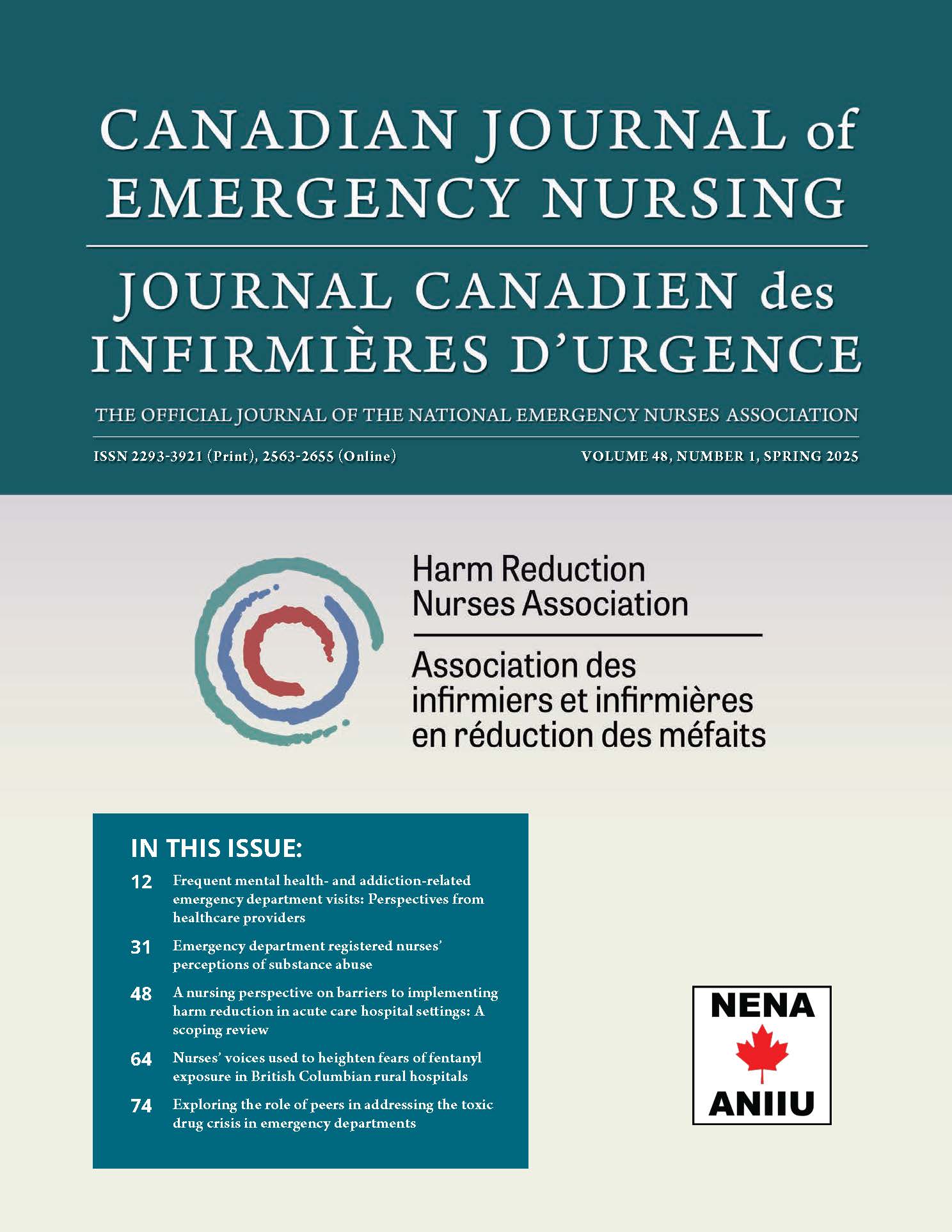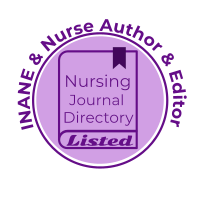English
DOI :
https://doi.org/10.29173/cjen248Mots-clés :
emergency department, substance use, toxic drug crisis, peer support workers, quality improvement, lived experienceRésumé
Résumé
Introduction : Les systèmes de soins de santé du
Canada affrontent un nombre élevé de patients qui utilisent
des drogues (PUD), qui ont un diagnostic de trouble
lié à l’utilisation de substances ou qui sont victimes
d’un empoisonnement aux drogues illégales, ce qui rend
nécessaire l’adoption d’approches novatrices en matière
de soins. En raison du nombre élevé d’intoxications aux
drogues, le personnel des services d’urgence est de plus
en plus confronté à l’épuisement professionnel et à la
détresse morale (Van Hout et O’Reilly, 2020). Un projet
pilote d’amélioration de la qualité a été mené pour incorporer
des personnes ayant une expérience de la consommation
de drogues illégales (c’est-à-dire des pairs)
dans les équipes des services d’urgence afin d’améliorer
les résultats pour les patients et de renforcer le soutien
du personnel, pour répondre à l’impact significatif de la
crise des drogues illégales toxiques sur les systèmes de
soins de santé.
Méthodes : Le projet s’est appuyé sur un cadre
d’amélioration de la qualité Planifier-Exécuter-Étudier-
Agir (PEÉA) et sur une évaluation à méthodes mixtes
axée sur l’utilisation pour évaluer l’impact de l’intégration
des pairs dans le service des urgences. Un modèle
de méthodes mixtes a été adopté pour recueillir des
données à partir de formulaires d’admission, d’enquêtes
sur l’expérience des patients et du personnel, et d’un
groupe de discussion semi-structuré composé de membres
du personnel de soutien par les pairs.
Résultats : Les principaux motifs de rencontre avec
les pairs (n = 764) étaient le soutien émotionnel, la
réduction des méfaits, un aiguillage, la consommation
en présence d’un témoin et la demande de produits
de nécessité de base. Selon les résultats de l’enquête
auprès des patients (n = 51), les pairs ont aidé la majorité
des patients à se sentir en sécurité et plus soutenus
lorsqu’ils accédaient à des soins d’urgence. Les membres
du personnel des urgences (n = 22) se sont montrés
positifs dans l’enquête sur le nouveau programme de
pairs, soulignant l’amélioration du soutien aux patients,
l’accès accru aux services de réduction des méfaits et
les progrès d’un système de soins de santé plus fiable.
Lors des groupes de discussion, les pairs (n = 2) ont
signalé l’importance d’intégrer ce rôle dans les services
d’urgence afin de s’assurer que les patients reçoivent
les soins dont ils ont besoin dans un environnement
à niveau de stress élevé qui, au fil du temps, a eu le potentiel de causer des dommages importants en raison
de la stigmatisation et des préjugés à l’égard des PUD.
Conclusion : L’intégration d’intervenants en services de
soutien aux pairs dans le service des urgences pendant
la crise des drogues illégales toxiques a amélioré
le soutien apporté aux patients et au personnel. Cette
stratégie pourrait également améliorer le moral du
personnel, réduire le stress de la charge de travail,
diminuer les préjugés à l’égard des PUD et améliorer les
soins prodigués aux patients. Le but est d’optimiser les
ressources et de renforcer l’expérience vécue par les
patients et les soignants en intégrant des pairs.
Références
Auger, O., & Local Journalism Initiative Reporter. (2023, April 24). Indigenous people
bear the brunt of the toxic drug crisis. The Canadian Press. Canadian Press Enterprises Inc. https://thetyee.ca/News/2023/04/24/Indigenous-People-Bearing-Brunt-Toxic-Drugs/
Bardwell, G., Kerr, T., Boyd, J., & McNeil, R. (2018). Characterizing peer roles in an
overdose crisis: Preferences for peer workers in overdose response programs in emergency shelters. Drug and Alcohol Dependence, 190, 6–8.
https://doi.org/10.1016/j.drugalcdep.2018.05.023
Boulton, O., & Farquharson, B. (2023). Does moral distress in emergency department nurses contribute to intentions to leave their post, specialisation, or profession: A systematic review. International Journal of Nursing Studies Advances, 6, Article 100164. https://doi.org/10.1016/j.ijnsa.2023.100164
Braun, V., & Clarke, V. (2014). What can "thematic analysis" offer health and wellbeing researchers? International Journal of Qualitative Studies on Health and Well-being, 9, 26152. https://doi.org/10.3402/qhw.v9.26152
British Columbia Coroner’s Service (2024). Statistical reports on deaths in British Columbia. Government of British Columbia. Retrieved December 4, 2024, from https://www2.gov.bc.ca/gov/content/life-events/death/coroners-service/statistical-reports
British Columbia Emergency Health Services (2023). Overdose and drug poisoning data. Retrieved July 12, 2024, from http://www.bcehs.ca/about/accountability/data/overdose-drug-poisoning-data
Brower, H. H., Nicklas, B. J., Nader, M. A., Trost, L. M., & Miller, D. P. (2021). Creating effective academic research teams: Two tools borrowed from business practice. Journal of Clinical and Translational Science, 5(1), Article e74. doi:10.1017/cts.2020.553
Brown, G., Crawford, S., Perry, G.-E., Byrne, J., Dunne, J., Reeders, D., Corry, A.,
Dicka, J., Morgan, H., & Jones, S. (2019). Achieving meaningful participation of people who use drugs and their peer organizations in a strategic research partnership. Harm Reduction Journal, 16(1), 37. https://doi.org/10.1186/s12954-019-0306-6
Chan Carusone, S., Guta, A., Robinson, S., Tan, D. H., Cooper, C., O’Leary, B., de
Prinse, K., Cobb, G., Upshur, R., & Strike, C. (2019). “Maybe if I stop the drugs, then maybe they’d care?”—Hospital care experiences of people who use drugs. Harm Reduction Journal, 16(1), 16. https://doi.org/10.1186/s12954-019-0285-7
Coll, M., Davis, S., Etherington, C., Mohammed, R., Macdonald, S., Scott, A., & Young, S. (n.d.). Peer framework for health-focused peer positions in the Downtown Eastsides. Retrieved August 11, 2024, from https://www.vch.ca/sites/default/files/import/documents/DTES-Peer-Framework.pdf
Coury, J., Schneider, J. L., Rivelli, J. S. (2017). Applying the Plan-Do-Study-Act (FSQUIRE) approach to a large pragmatic study involving safety net clinics. BMC Health Services Research, 17, Article 411. https://doi.org/10.1186/s12913-017-2364-3
Crisanti, A. S., Earheart, J., Deissinger, M., Lowerre, K., & Salvador, J. G. (2022). Implementation challenges and recommendations for employing peer support workers in emergency departments to support patients presenting after an opioid-related overdose. International Journal of Environmental Research and Public Health, 19(9), Article 5276. https://doi.org/10.3390/ijerph19095276
Cullen, J., Childerhouse, P., Jayamaha, N., & McBain, L. (2023). Developing a model for primary care quality improvement success: A comparative case study in rural, urban and Kaupapa Māori organisations. Journal of Primary Health Care, 15(4), 333–342. https://doi.org/10.1071/HC23046
Dow-Fleisner, S. J., Lomness, A., & Woolgar, L. (2022). Impact of safe consumption facilities on individual and community outcomes: A scoping review of the past decade of research. Journal of Substance Use and Addiction Treatment, 141, Article 108923. https://doi.org/10.1016/j.jsub.2022.108923
Faiman, B., & Tariman, J. D. (2019). Shared decision making: Improving patient outcomes by understanding the benefits of and barriers to effective communication. Clinical Journal of Oncology Nursing, 23(5), 540-542. https://doi.org/10.1188/19.CJON.540-542
First Nations Health Authority. (2022). First Nations and the toxic drug poisoning crisis in BC: January–December 2022. Retrieved from https://www.fnha.ca/Documents/FNHA-First-Nations-and-the-Toxic-Drug-Poisoning-Crisis-in-BC-Jan-Dec-2022.pdf
Fraser Health (2023). Monthly overdose data reports. Retrieved August 11, 2024, from https://www.fraserhealth.ca/health-topics-a-to-z/mental-health-and-substance-use/overdose-prevention-and-response/monthly-overdose-data-reports
Fraser Health. (n.d.). About Fraser Health. Retrieved December 4, 2024, from https://www.fraserhealth.ca/about-us/about-fraser-health
Greer, A. M., Amlani, A., Burmeister, C., Scott, A., Newman, C., Lampkin, H., Pauly, B., & Buxton, J. A. (2019). Peer engagement barriers and enablers: Insights from people who use drugs in British Columbia, Canada. Canadian Journal of Public Health, 110(2), 227–235. https://doi.org/10.17269/s41997-018-0167-x
Health Canada. (2021). Opioid-related poisoning and anoxic brain injury in Canada: A descriptive analysis of hospitalization data. Canada.ca. https://www.canada.ca/en/health-canada/services/opioids/opioid-related-hospitalizations-anoxic-brain-injury.html
Johnson, P. & Raterink, G. (2009), Implementation of a diabetes clinic-in-a-clinic project in a family practice setting: Using the plan, do, study, act model. Journal of Clinical Nursing, 18, 2096-2103. https://doi.org/10.1111/j.1365-2702.2008.02774.x
Jongbloed, K., Pearce, M. E., Pooyak, S., Zamar, D., Thomas, V., Demerais, L., Christian, W. M., Henderson, E., Sharma, R., Blair, A. H., Yoshida, E. M., Schechter, M. T., & Spittal, P. M. (2017). The Cedar Project: Mortality among young Indigenous people who use drugs in British Columbia. Canadian Medical Association Journal, 189(44), E1352–E1353. https://doi.org/10.1503/cmaj.160778
Kennedy, M. C., Boyd, J., Mayer, S., Collins, A., Kerr, T., & McNeil, R. (2019). Peer worker involvement in low-threshold supervised consumption facilities in the context of an overdose epidemic in Vancouver, Canada. Social Science & Medicine, 225, 60–68. https://doi.org/10.1016/j.socscimed.2019.02.014
Laursen, M., Svejvig, P., & Rode, A. (2017, August). Four Approaches to Project Evaluation. . Paper presented at the 24th Nordic Academy of Management Conference, Bodo, Norway. https://www.researchgate.net/publication/338389234_Four_Approaches_to_Project_Evaluation
Mamdani, Z., McKenzie, S., Pauly, B., Cameron, F., Conway-Brown, J., Edwards, D., Howell, A., Scott, T., Seguin, R., Woodrow, P., & Buxton, J. A. (2021). “Running myself ragged”: Stressors faced by peer workers in overdose response settings. Harm Reduction Journal, 18(1). https://doi.org/10.1186/s12954-020-00449-1
Olding, M., Boyd, J., Kerr, T., & McNeil, R. (2021). "And we just have to keep going":
Task shifting and the production of burnout among overdose response workers with lived experience. Social Science & Medicine, 270, Article 113631.
https://doi.org/10.1016/j.socscimed.2020.113631
Pauly, B., Mamdani, Z., Mesley, L., McKenzie, S., Cameron, F., Edwards, D., Howell, A., Knott, M., Scott, T., Seguin, R., Greer, A., & Buxton, J. (2021). “It’s an emotional roller coaster… but sometimes it’s fucking awesome”: Meaning and motivation of work for peers in overdose response environments in British Columbia. International Journal of Drug Policy, 88, 103015. https://doi.org/10.1016/j.drugpo.2020.103015
Piatkowski, T., Seear, K., Reeve, S., & Kill, E. (2024). How do relational practices co-constitute care for people who use drugs? the social and political dimensions of peer-led harm reduction. International Journal of Drug Policy, 133, 104614. https://doi.org/10.1016/j.drugpo.2024.104614
Richardson, J. & Rosenberg, L. (2018). Peer support workers in emergency departments: Engaging individuals surviving opioid overdoses-Qualitative assessment. Providers Clinical Support System. https://pcssnow.org/wp-content/uploads/2018/07/Peer-Support-Workers-in-EDs-Issue-Brief-1.24.19.pdf
Scheeres, J. (2015). Strategies for accelerating and sustaining change in healthcare organizations. ResearchGate. https://www.researchgate.net/publication/229003265_Strategies_for_Accelerating_and_Sustaining_Change_in_Healthcare_Organizations
Scow, M., McDougall, J., Slaunwhite, A., et al. (2023). Peer-led safer supply and opioid agonist treatment medication distribution: A case study from rural British Columbia. Harm Reduction Journal, 20, 156. https://doi.org/10.1186/s12954-023-00883-x
Smith, J., Brown, L., & Johnson, M. (2020). The role of peer support in enhancing healthcare quality and reducing staff burnout: A systematic review. Journal of Healthcare Management, 65(4), 299–310. https://doi.org/10.1097/JHM-D-20-00004
Squire (2015). Revised Standards for Quality Improvement Reporting Excellence (SQUIRE 2.0). https://www.squire-statement.org/index.cfm?fuseaction=page.viewpage&pageid=471
Statistics Canada (2023). Census Profile. 2021 Census of Population. Statistics Canada Catalogue no. 98-316-X2021001. Ottawa. Released November 15, 2023. https://www12.statcan.gc.ca/census-recensement/2021/dp-pd/prof/index.cfm?Lang=E
The Neighbourhood Group. (n.d.). Peer Training and Development. TNG Community Services. Retrieved August 11, 2024, from https://www.tngcommunityto.org/Programs-Services/Programs/Peer-Programs/Peer-Training-and-Development?cat=
Van Hout, M. C., & O'Reilly, K. (2020). Emergency department visits related to drug use and drug overdose: Impact on emergency department and healthcare workers. Journal of Substance Use and Addiction Treatment, 28(3), 195-204. https://doi.org/10.1016/j.jsuat.2020.01.002
Téléchargements
Publié-e
Comment citer
Numéro
Rubrique
Licence
© Janelle Tarnow, Rita Metwally, Aven Sidhu, Jade Black, Tracy Stoneson, Mary Van Osch, Kassaundra Benoit, Kim Wood 2025

Cette œuvre est sous licence Creative Commons Attribution 4.0 International.
The Canadian Journal of Emergency Nursing is published Open Access under a Creative Commons CC-BY 4.0 license. Authors retain full copyright.




